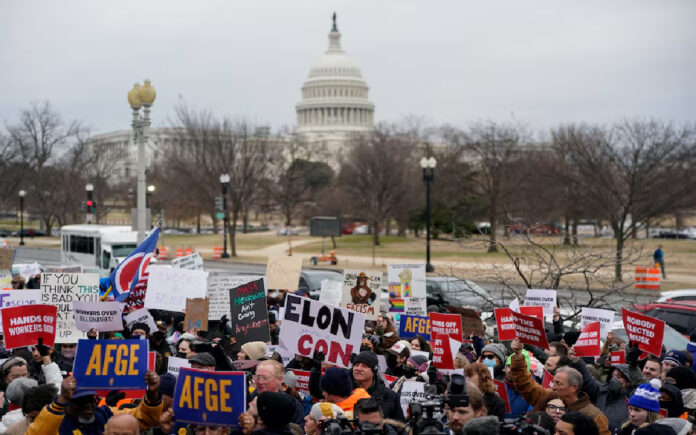Washington: A U.S. judge has temporarily halted the Trump administration’s federal worker buyout program, granting an early victory to labor unions that challenged the initiative in court. The ruling, issued on Thursday by U.S. District Judge George O’Toole in Boston, postpones the implementation of the program until at least Monday.
Despite the legal setback, over 60,000 federal employees have already opted into the buyout, a White House source told Reuters. The program, which faced a midnight deadline, is a central component of the Trump administration’s broader efforts to reshape the federal workforce by significantly reducing its size. O’Toole is set to revisit the case on Monday and may choose to extend the delay or impose a more permanent injunction.
The White House confirmed that employees could still submit their plans to resign until 11:59 p.m. ET on Monday. The buyout proposal is part of President Donald Trump’s sweeping plan to curb what he sees as bureaucratic inefficiencies and federal overreach, which he has frequently blamed for obstructing his policy agenda.
Drastic Downsizing of Federal Agencies
As part of this restructuring, the Trump administration is executing a large-scale reduction at the U.S. Agency for International Development (USAID), which oversees humanitarian aid worldwide. According to four sources who spoke to Reuters, the administration plans to retain fewer than 300 employees from a global workforce that currently exceeds 10,000.
The buyout initiative has sparked widespread opposition, triggering street protests and legal action from labor unions and Democratic lawmakers. Critics argue that the move violates multiple labor laws and undermines the stability of federal institutions. Employees were instructed to indicate their participation by replying to an official email with the word “RESIGN” in the subject line.
While the buyout offer guarantees continued salary and benefits until October, there is uncertainty over whether these payments will be sustained. The current federal spending authorization expires on March 14, and there is no assurance that funds will be available beyond that date. The Education Department has already cautioned employees that paychecks could cease at any moment, reinforcing concerns raised by unions and Democratic officials that the offer lacks credibility.
Legal Challenges and Privacy Concerns
The administration’s aggressive approach to workforce reduction has drawn additional scrutiny, particularly over its decision to enlist billionaire Elon Musk to oversee the downsizing. Musk’s team has reportedly sought access to personnel files and payroll records across various agencies, raising alarms about data privacy and security.
New York Attorney General Letitia James announced that she and seven other Democratic attorneys general intend to file a lawsuit to block Musk’s newly formed “Department of Government Efficiency” from obtaining sensitive federal employee information.
“The president does not have the power to give away our private information to anyone he chooses,” James stated.
The White House defended its actions, asserting that the program aligns with Trump’s campaign commitment to reducing what his administration perceives as wasteful government spending. Conservative policymakers have long criticized the federal bureaucracy as overly expansive and resistant to presidential directives.
Uncertainty Among Federal Workers
The buyout program has created an atmosphere of uncertainty and anxiety among federal employees. Many workers have been downloading their pay and benefits records, fearing that critical employment data could be erased from government databases. The decision to accept the buyout or risk termination has left employees feeling trapped between two undesirable choices.
“In the halls, most people are stopping to ask one another what their decision will be, with many saying they are scared because we are caught between two bad choices and very little time to make the decision,” said a Treasury Department executive, who requested anonymity.
Currently, the 60,000 employees who have opted into the program represent roughly 2.5% of the federal workforce, which totals 2.3 million. It remains unclear which agencies will be most affected by the departures. Historically, about 6% of federal employees retire or resign annually, according to data from the nonprofit Partnership for Public Service.
The Trump administration has reportedly informed workers that they may face termination if they do not accept the buyout. Employees have been advised to prepare for significant job cuts, reinforcing concerns about the administration’s intent to downsize as quickly as possible.
Also Read | Ellen Weintraub Says Trump Has No Legal Authority to Remove Her
“We were told that nothing that is happening is normal and the goal is to reduce the workforce as fast as possible,” an executive at the Internal Revenue Service said.
New Criteria for Workforce Reduction
The administration’s efforts to streamline the federal government extend beyond voluntary resignations. A newly issued memo, sent on Thursday to agency heads, mandates the identification of employees who received less than a “fully successful” performance rating within the past three years. The directive instructs agencies to remove obstacles that could hinder the “swift termination of poor-performing employees.”
Additionally, the White House has ordered agencies to compile lists of employees hired within the last two years, as these individuals have fewer civil service protections and are easier to dismiss. Another targeted group includes holdovers from the Biden administration who remain in government roles, as well as workers with documented performance deficiencies.
Also Read | Lawsuit Filed Against Trump Over USAID Shutdown Amid Humanitarian Crisis
Reports have surfaced suggesting that the administration is preparing to direct the Food and Drug Administration (FDA) and other health agencies to implement mass layoffs. However, the White House has denied these claims.
With legal battles unfolding and uncertainty gripping the federal workforce, Monday’s court hearing will be a critical juncture in determining the fate of Trump’s buyout program.



